The Aurorasound HFSA-01 EL84 Integrated Amplifier by David Abramson
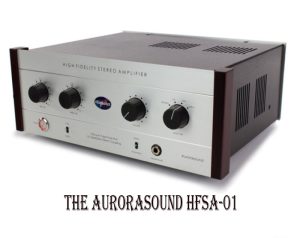
 Depending on whom you ask, our hobby either needs more oscilloscopes (objectivists), fewer designs-by-ear (also objectivists), more record players (people with too much time and/or money on their hands), or more young people (older people).
Depending on whom you ask, our hobby either needs more oscilloscopes (objectivists), fewer designs-by-ear (also objectivists), more record players (people with too much time and/or money on their hands), or more young people (older people).
One thing it may not be in need of, though, is another EL84 tube amp. Doctor John’s Cheaptubeaudio.com site has a lovely article on the breed and tells us: “The ubiquitous EL84 (American designation 6BQ5) was developed by Philips in 1953 and introduced to market by Mullard by 1954. The latest in a series of miniature output pentodes developed by Philips, its lineage stems from the superb EL11 and EL3N tubes of the pre-war period. Indeed, at that time Philips was the largest patent holder in Europe, and their engineers were on the bleeding edge of advancing vacuum tube technology. We still see plenty of the EL84 today, likely due to its introduction at the beginning of the ‘golden era’ of hi-fi, as well as its popularity in guitar amps dating back to the ‘British Invasion’ of the 1960s.”

The Leben 300xs is a modern-day classic, and the original Zen amp from modern-day darling (of the two-year wait list) Decware was a single-ended EL84. Linear Tube Audio’s David Berning designed his Z10 around this tube, and Finale Audio’s EL84 amps are popular with our brethren in the (once?) colder climes above our northern border. Eico, Dynaco, and Leak all made and sold lots of EL84-based models. These days more affordable audio producers like Black Ice Audio with their FX10 and any number of Amazon sellers offer a wide array, and such amps are surely a boon in attracting new victims… I mean hobbyists.
I won’t continue, but the EL84 certainly will, long after you and I have left this planet and are surfing with the (recently revealed/whistleblown) aliens.
Yes, the EL84 and the Dude will both abide. There are just too many companies making them and, by extension, too many people clamoring for them, and that’s probably all because in the words of one of my wizened (grizzled?) EL84-loving audio buddies, “it’s just hard to make an EL84 amp sound bad.” When I told him I was reviewing the Aurorasound HFSA-01, he opined via email, “I love the EL84 tube. It has some wonderful characteristics and was designed to require a very simple circuit, which equates to more opportunities for designers to get it right. Some get it righter than others but I do feel it’s hard to make the EL84 sound bad. Transformers, etc. require great care but the EL84 less so than most other power tubes. I’ll be curious as to your impressions on whether they have been able to design an appropriate front end with op-amps rather than the traditional circuit (think two 12ax7’s driving four EL84’s). If you like it, maybe I’ll get one!”
I stopped him right there. “Man!” I told him, “You just wrote half my review. Thanks!” Maybe we should hire HIM to review this amp. Well, in any case, you’re all better off because I’m your conduit here for his wisdom.
He, by the way, currently lives with a heavyweight champion fire-breathing 211 amp and a pair of EL34 monos, but you can just hear the EL84 lust burning deep within his soul, yearning to breathe free…
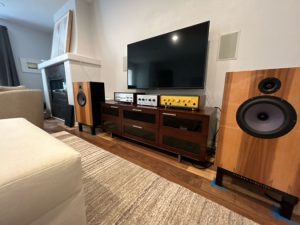
In particular, this EL84…
So to the Aurorasound here before me, yeah, it’s an EL84, but the Aurorasound does things… differently. It’s its own beat or its own drum kit. Instead of the aforementioned time and shopworn EL84 blueprint, designer Shinobu Karaki-san’s Aurorasound utilizes (are you seated?) transistors as the drivers for the tubes (hey- I’m just the messenger) along with solid-state rectification. You see, the Aurorasound (pours and takes a quick belt of Jameson on the rocks) is… [those with a weak constitution look away, and if you’re in a Sunday dress, well, those pearls aren’t gonna clutch themselves] a hybrid.

But get this whilst clutching: within one hour of hookup and warm up from new and cold, you coulda knocked me over with an audiophile-approved carbon fiber feather if you told me:
A. This amp is a non-standard ‘experimental’ hybrid topology and…
B. It’s $3,600 bucks retail as supplied.
 That’s because it sounds like…well… like a really, really good tube amp (and I have several here!) that’s none too tubey, none too sterile, and none too anything except super musical. It is preternaturally clean, ebullient, punchy, and textured. In fact (quickly rummages through a bag of audiophile adjectives), it’s downright effervescent!
That’s because it sounds like…well… like a really, really good tube amp (and I have several here!) that’s none too tubey, none too sterile, and none too anything except super musical. It is preternaturally clean, ebullient, punchy, and textured. In fact (quickly rummages through a bag of audiophile adjectives), it’s downright effervescent!
Fun fact: Shinobu Karaki-san worked as an engineer for Texas Instruments for almost three decades and therefore possesses the street cred to use transistors in non-standard or stand-in ways and get away with it. Indeed, he seems here to have more than ‘gotten away with it.’
In this case, it is certainly not like the dog walking on his hind legs thing (it’s not that he does it well, but that he does it at all). He HAS done it well… and ‘it’ is a great and noble thing.
 Namely, he has created an op-amp/tube combo circuit that really does combine the best of solid-state low-end punch and drive with the (not at all overdone) punchy/spacey liquidity of EL84 tubes in the mids and highs, resulting in a lively, spacious, punchy sound which occurs within expansive spaces that suggest much pricier ‘purist’ tube or solid-state amps. It could be the active preamp circuitry I’m told lies within instead of the typical passive Alps pot I’m used to seeing, possibly coupled with the lack of an electrically ‘noisy’ remote (grumble…), but the sonic spaciousness and clarity on offer? I could go on. Please let me know.
Namely, he has created an op-amp/tube combo circuit that really does combine the best of solid-state low-end punch and drive with the (not at all overdone) punchy/spacey liquidity of EL84 tubes in the mids and highs, resulting in a lively, spacious, punchy sound which occurs within expansive spaces that suggest much pricier ‘purist’ tube or solid-state amps. It could be the active preamp circuitry I’m told lies within instead of the typical passive Alps pot I’m used to seeing, possibly coupled with the lack of an electrically ‘noisy’ remote (grumble…), but the sonic spaciousness and clarity on offer? I could go on. Please let me know.
Some listening for the benefit of the people
Just prior to hooking up Aurorasound, I was listening to and really enjoying my terrific new Luxman cl-38uc preamp (which offers many of the self-same qualities of the Aurorasound). I bought this pre from my ‘personal’ salesman/audio hound Mario Alonzo at TMRaudio.com (shameless unpaid plug–, but I love them and him! Mario@TMRaudio.com forever!) hooked to the terrifically articulate and balanced Enleum AMP-23R I have in for follow-up review.
Lemme tell you, it was readily apparent the Aurorasound brings much of the gestalt and gravitas of this roughly $12k MSRP combo, similar spaciousness and tone, and sheer fun to bear for around $8 or $9k less and does some things even better.
I mean, Bill Evans’s piano on ‘Some Other Time’ seemed life-sized, physically present in-room and way out west to the left, and the depth and breadth of the stage on Meshell Ndegeocello’s ‘The Omnichord Real Book,’ to say nothing of the fire and dynamism, was just enveloping. Really unexpected in an amp of this size and wattage. Wow! My new favorite Audio Art e-Statement cryo speaker and interconnect cables also happened to be a favorite of the HFSA-01, so that really helped matters, too, adding just a bit of warmth while maintaining the clarity!
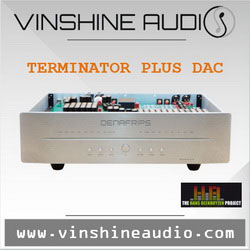 Sure, space and sure, depth and breadth, but the Aurorasound sound is, first and foremost, fun! Like my old Naim Nait 2 and Nait 3 were, it’s somehow similarly enlivened; but to my recollection, infused with more better tone and texture than those venerable speed demons.
Sure, space and sure, depth and breadth, but the Aurorasound sound is, first and foremost, fun! Like my old Naim Nait 2 and Nait 3 were, it’s somehow similarly enlivened; but to my recollection, infused with more better tone and texture than those venerable speed demons.
To wit, I usually run through some classical albums and some jazz trios and something obscure like Diana Krall (I kid!! I kid!!!) before moving to other ‘inferior’ genres like Taylor Swift (I kid! I kid again! Please don’t sue!), but the Aurorasound had me queuing up Vampire Weekend ‘Modern Vampires of The City’ and ‘Father of the Bride’ in short order ‘cause I just KNEW I had to leave Beethoven and Bill Evans land and listen to fun, upbeat music on the Aurorasound! It just forces you to do it; you have no choice in the matter. This thing is positively bouncy! You wanna turn it up, then from the couch, you realize it has no remote control. And you are sad. For a minute. Until you realize Roon AND your streamer both have digital volume controls. Then you are happy again, and you return to Vampire Weekend and think you’re (still) cool.
You sip your favorite Gran Dovero Reposado tequila (seriously, it’s really good stuff), and genetically, you have no tolerance, so immediately a bit buzzed, you think, ‘yeah, this is an amp I can see myself with long term. Maybe even exclusively.’
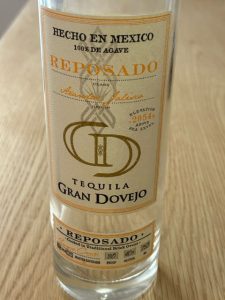
Classical Clarity
 With ‘Kratt” on the Alpha classics label, which includes works by composers previously unknown to me, such as Tubin, Lutoslawski, and Bacewicz from a live recording at the Parnu Music Festival, the Aurorasound again embodied some of my favorite adjectives for it; ebullient, energetic and textured. String textures here were readily apparent, and the HFSA-01 resolved detail better than most any amp I’ve had through here, clarifying and illuminating and generally bringing this beautiful collection of heretofore unfamiliar (to me) symphonic pieces to life in my listening/living room.
With ‘Kratt” on the Alpha classics label, which includes works by composers previously unknown to me, such as Tubin, Lutoslawski, and Bacewicz from a live recording at the Parnu Music Festival, the Aurorasound again embodied some of my favorite adjectives for it; ebullient, energetic and textured. String textures here were readily apparent, and the HFSA-01 resolved detail better than most any amp I’ve had through here, clarifying and illuminating and generally bringing this beautiful collection of heretofore unfamiliar (to me) symphonic pieces to life in my listening/living room.
Its clarity, by the way, seems to make it particularly adept at late-night (me) and early-morning (not me) levels, and it seems not to lose much, if any, punch at these housemate-approved levels. Communally living audiophiles, take note!
As with the Feliks Audio 300B amp I had in-house recently, the HFSA-01 has both 4 and 8 Ohm outputs, and my nominally 8-10 Ohm Devores did well with either though perhaps the 4-ohm tap might have been a bit punchier while the 8-ohm tap might have been a bit bloomier and more seductive. Just like with the Feliks, I believe I prefer the 4-ohm tap. Your impedance may vary. The Aurorasound incidentally is more detailed than the Feliks and not quite as bloomy in the bass; more defined. It’s also somewhat pacier and punchier.
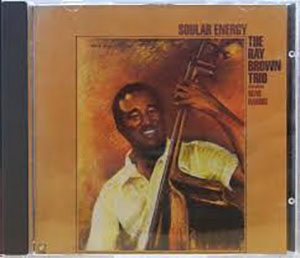 Exactly like You from Best of the Ray Brown Trio showcased two of the special attributes of the Aurorasound; namely, it is especially dynamic (macro and micro) and especially well defined in the mid-bass. The Devore O/96 is certainly not short on mid-bass weight and punch, but if you don’t control those big 10-inch woofers, you can be courting excess in this region, particularly with the closer to the front wall placement my multi-use room forces.
Exactly like You from Best of the Ray Brown Trio showcased two of the special attributes of the Aurorasound; namely, it is especially dynamic (macro and micro) and especially well defined in the mid-bass. The Devore O/96 is certainly not short on mid-bass weight and punch, but if you don’t control those big 10-inch woofers, you can be courting excess in this region, particularly with the closer to the front wall placement my multi-use room forces.
The Aurorasound, more so than the Feliks 300b amp I had here and perhaps more so than either the terrific Enleum AMP-23R or the Leben 600x I have here, controls and defines the mid-bass. What you end up with is punch allied to definition instead of bloat. This allows you to hear the intonation and nuance in this region in a way that you simply can’t with sundry amps of varying topologies and power ratings (and prices), in my experience.
And yet, there is no perceived loss of weight. Perhaps we don’t get the sheer meatiness, scale, and weight of, say, the Leben 600x, but we gain a bit of clarity and separation.
On Freddie Freeloader, Ray Brown plays a descending scale on the standup bass, and you can hear the string texture and woody resonances as separately defined notes descending down into the lowest reaches of the scale just as clearly as you can on the higher end.
Taking The Real Blues (live) from the same Ray Brown album. There is simply something about the way the Aurorasound plays music, the gestalt of things, the energy, presence, and little rhythmic syncopations that cause you to feel that, at least in spirit, this must have been what it was like there at the venue that night And the horn tone on the trio’s ‘Porto Rico’? By turns, weighty, breathy, smooth, or golden, just like any number of tube amps with great tone, but only some of these golden devices have a concomitant inability to muster the rhythmic energy the Aurorasound tone rides on.
Returning to Meshell Ndegeocello, acapella voices on Hole in The Bucket from “The Omnichord Real Book” album mentioned above were nuanced, breathy, present, and distinct. Let’s also shout out Meshell Ndegeocello’s own sultry, breathy in-room-present voice throughout her album Bitter. I don’t think I’ve heard such presence through these speakers, with other amps passing through.

Ok, maybe there is not the sheer sweep and power of the live thing for sure (I’m in a living room with 14 watts), but I mean the presence of it and the feel of the event in progress, the audience interplay on live recordings, for example, seem in some subtle ways unlike many an amp I’ve heard in any of my systems; somehow more of-the-moment and alive.
Apologies here for mere words, but that’s the best I can do in trying to convey the feel of listening through an amplifier that generates this certain brand of live ‘feel’ for events long past.
Strictly measurably accurate or not, whatever it’s doing or isn’t, it’s a terrific conduit for the buoyancy, rhythm, and energy of recorded music, and in this regard, particularly as Ray and the boys hit the gas on the live version of Don’t Get Sassy, this little dynamo is perhaps the best I’ve heard at letting you forget about speakers and amplifiers and hi-fi. It just does that life-affirming thing it does, and it does it on albums you’ve heard before many times on many systems.
I even forgot it doesn’t have a remote control. Ok, I still haven’t.
I hold that against it to this day. Fortunately, Roon has a digital volume control, and so does my Innuos Pulse streamer. Still, does a remote really mess up the sonics that much!!? (I’m looking at YOU Audio Note and Leben! And now at YOU, Aurorasound!) Still, no remote with this amp is almost… quaint. Given the bare-bones sort of Luxman-on-a-budget design aesthetic of the HFSA-01, I can almost understand why a remote just doesn’t fit.
Now I also didn’t forget this music machine has a headphone socket. Since I’ve been on an MN tear lately (Meshell Ndegeocello), the bass on ‘Don’t Disturb this Groove’ from her album Ventriloquism was next level, like you think ‘How are my headphones vibrating my shoulders’ kind of thing. And with whatever I played, even if it wasn’t Meshell, the instrumental separation, micro dynamics and bass punch were just what you’d expect when listening to the amp driving your speakers. Same majesty, same rare musicality.
Comparisons
By way of comparison with my perennial Lejonklou Boazu and the Enleum AMP-23R, I just revisited with my O/96s, both of these classy contenders have more power and a remote! One of them, the Enleum, has a spectacular headphone output too. I’d characterize the Boazu ethos as more laid back and a bit warmer in presentation than the Aurorasound. You can play with wires to some degree to alter that if you like.
The Boazu, as I’ve previously written, has great pace, and its bass is potent though it may not have quite the definition of the HFSA-01. The Enleum is balanced and articulate in terms of its presentation and maybe again slightly less defined in the bass and slightly less micro-dynamic with a slightly ‘grayer’ background, but the two run each other very close, and I could live happily with either! Plus, the Enleum has ten more watts and a remote.


And what of a bit more recent surprise visitor to these digs, the (legendary?) Leben 600x? Well, the Leben is slightly more rounded and weighty than the HFSA-01, generally speaking, but that could be a positive or a negative, depending on your tonal preferences and system. As I am finding, it can also very much be tailored to taste via tube choice and cabling.
The HFSA-01 and the 600x are both (especially!) fleet of foot, punchy and dynamic, though the Aurorasound is a bit ‘cleaner’ sounding, and the Leben is a bit thicker with the sort of golden thread throughout its tone that my Shindo gear had (Aurieges pre and Montille CV391 amp). Which to prefer!!? Ahhh. I’ll leave that to you, but if you need more power than the 14-watt Aurorasound and your tastes bend towards tubes and a touch of gold in your sound, that would be the Leben. Neither is ‘better,’ and with the 0/96’s, I could live with either/or. Wait; the Leben faceplate is gold, and the Aurorasound’s is silver, and that’s pretty much exactly how they sound:)
All three amps, in sum, are persuasive musical arguments, but, in this case, if all you need is low power and don’t mind the lack of a remote because your dac has one or Roon has one, or you just love hopping up and down from the couch, well then I’d have to give a slight nod tonally and dynamically to the Aurorasound.
With a speaker like the O/96 at my preferred levels, it could be my main squeeze. With lower-efficiency speakers and larger (non-huge) rooms, I might gravitate toward the other two amps…
Concluding summations
Listen, the Beatles were right. Yeah, about Yesterday and troubles and all that, but also about the EL84. No, I haven’t heard all or many (or almost any) EL84 amps, but somehow I doubt many of them sound exactly like THIS EL84 amp because none of them, to my knowledge, are hybrids. And also because no or nearly no amplifiers of any topology in my experience can, within the context of watt-appropriate transducers, convey the sum and substance of music like the Aurorasound can.
Some amps love classical, some seem to rock out, and this guy loves live performances; it somehow kicks up the energy and audience interplay kind of thing. It’s exciting.
Caveats? Sure. I don’t know how much of the Hikari, the light and life of the Aurorasound, is due to the SR Master fuse upgrade within my unit. You see, distributor Alfred Kainz is offering fuse upgrades for very reasonable prices when you order your Aurorasound. He will install an SR Purple fuse for an upcharge of a few hundred bucks and the latest SR Master fuse for a bit more. He tells me that, in their view, it’s totally worth it, and these specific fuse upgrades in this amplifier work magic.

 Since the SR Master fuse retails for $595.00(!), and I can’t say how much of the energy and life of this amp is down to that fuse, downgrade to a 10-cent fuse at your own risk. Its presence may also have been responsible for some of the amps break in time, as, despite a 24-hour factory run-in, it did seem to improve and smooth out a bit over the first 100 or 200 hours I let it play. It so happens that the timeframe roughly corresponds to the recommended break-in time for the SR Master fuse.
Since the SR Master fuse retails for $595.00(!), and I can’t say how much of the energy and life of this amp is down to that fuse, downgrade to a 10-cent fuse at your own risk. Its presence may also have been responsible for some of the amps break in time, as, despite a 24-hour factory run-in, it did seem to improve and smooth out a bit over the first 100 or 200 hours I let it play. It so happens that the timeframe roughly corresponds to the recommended break-in time for the SR Master fuse.
As an aside, our editor Clement loves QSA fuses, and to see if he was hearing things, I sampled a few of these fuses from Mike at Tweekgeek.com last year, and all I can say is Clement’s perception of reality is intact.
If you haven’t heard the sonic differences these fuses make because you’re busy looking at your oscilloscope, then no amount of ‘rational and cogent’ argumentation that they can’t do what they say they do will suffice. You simply must borrow some fuses (or the equivalent outlet plugs with the same sonic benefits) as I did and see for yourself. If you hear no difference, you have my total support! If you do hear one, however, then you’re welcome; you are now just as confused as I am as to what exactly these things do, but I cannot deny they indeed do it. It wasn’t even that hard to hear, nor was it universally beneficial.
You may not even prefer the most expensive ones in your system. In fact, I think I ended up preferring the 100-dollar fuse/outlet plug to a 400-dollar one, etc. In any case, there is no denying an amplifier is the sum total of its parts and the relative electrical synergy thereof, and in the case of the Aurorasound HSFA-01 under review here, one of those parts happens to be a $600 fuse. Hey, I wouldn’t change a thing!
So my hat is off, and my head is bowed to Shinobu Karaki-san. This one is special. If amplifiers were akin to people, the Aurorasound HFSA-01 might be Garland or Sinatra, born and bred to perform.
In answer to your next question, yes, of course, I bought the review sample. I can’t let this one go…
I bid you peace
Specifications:
– Retail price as tested (with SR Master fuse):
3600.00
-Input: RCA unbalanced – CD, LINE-1, LINE-2, Phono-MM (Gain 40dB, load resistance 47kΩ, RIAA +/-1dB)
– TONE Control: BASS +/-12dB, TREBLE +/-12dB
– Output: 14W + 14W into 8Ω speaker
– Frequency response: 10Hz ~ 40kHz, -3dB, Flat
– THD+N: 0.08%, 1kHz, 2W, A-weighted
– SNR: 93dB, LINE IN-OUT
– Functions: TONE control pass DIRECT SW, Stereo/Mono, Headphones output
– AC voltage: USA model 120V, Europe/Asia model 220V, 240V
– Upgrade to SR MASTER fuse available (+$250)
– Power consumption: 150W
– Size / Weight: W360 x D320 x H145mm / 10.3kg (14 x 12.5 x 5.7inch / 22.7lbs)
Contact: https://highend-electronics.com
David’s Associated Equipment
Digital source:
Innuos Pulse streamer; Mac Mini 2014 w/Roon and/or Audirvana Studio; Holo Audio KTE May DAC
Amplification:
Leben 600x integrated amplifier; Enleum AMP-23R integrated amplifier; Feliks Audio Arioso 300b integrated amplifier; Lejonklou Boazu integrated amplifier; Luxman cl-38uc preamplifier
Loudspeakers:
Devore 0/96’s; Xavian Perla Esclusivas
Cables:
Audio Art Cable Statement e SC Cryo speaker wires and interconnects; Belden 8402 interconnects; Audio Note ISIS interconnects; Audioquest Carbon USB cable
Accessories:
Symposium Svelte Shelf Plus and Rollerblock Jr. footers (under Holo KTE May DAC); PS Audio P12 power conditioner
Stereo Times Masthead
Publisher/Founder
Clement Perry
Editor
Dave Thomas
Senior Editors
Frank Alles, Mike Girardi, Russell Lichter, Terry London, Moreno Mitchell, Paul Szabady, Bill Wells, Mike Wright, and Stephen Yan,
Current Contributors
David Abramson, Tim Barrall, Dave Allison, Ron Cook, Lewis Dardick, John Hoffman, Dan Secula, Don Shaulis, Greg Simmons, Eric Teh, Greg Voth, Richard Willie, Ed Van Winkle, and Rob Dockery
Site Management Clement Perry
Ad Designer: Martin Perry







Be the first to comment on: The Aurorasound HFSA-01 EL84 Integrated Amplifier by David Abramson